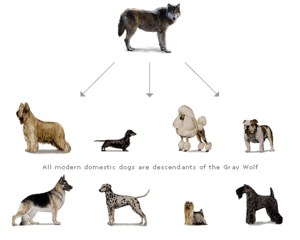Evolution of Dog Breeds
Introduction
The evolution of dog breeds is an interesting story of human involvement in the domestication of a wild animal. The domestic dog is called Canis familiaris The artificial selection of dog breeds has led to diversity in size, conformation, and pelage seen today in domestic canines[1]. The dog evolved approximately 12,000-15,000 years ago when early humans domesticated animals and plants for farming during the Stone Age. There are different views on how dogs evolved- was their evolution due to humans selecting animals for domestication, or was it that the animals had to evolve because they were in a new ecological niche (co-existing with humans in a domestic setting)? [2] Through phylogenetic analysis of dog and gray wolf mitochondrial DNA (mtDNA) sequences, it was found that domestic dog sequences are found in at least four distinct clades, implying a single origination event and at least three other origination or interbreeding events [3]. Further studies have concluded that dogs originated in Siberia[4].
Genetics
Current research includes the evolution of facial features of domestic dogs, more specifically "puppy dog eyes", to better communicate with humans. The research found that dogs have evolved new muscles around the eye that can raise their eyebrows. The scientists and psychologists on the research team believe that by raising their eyebrows, dogs are making their eyes appear larger and more infant like[5].
Microbiome
Include some current research, with a second image.
Conclusion
Overall text length should be at least 1,000 words (before counting references), with at least 2 images. Include at least 5 references under Reference section.
References
- ↑ C Vilá et. al."Phylogenetic relationships, evolution, and genetic diversity of the domestic dog." 1999.
- ↑ D. Morey. "The Early Evolution of the Domestic Dog." 1994.
- ↑ Ostrander et. al. "The Canine Genome." 2005.
- ↑ Leathlobhair et. al. "The Evolutionary History of Dogs in the Americas." 2014.
- ↑ Kaminski et. al. "The Evolution of Puppy Dog Eyes." 2019.
Edited by Tillie Wang, student of Joan Slonczewski for BIOL 116 Information in Living Systems, 2019, Kenyon College.

